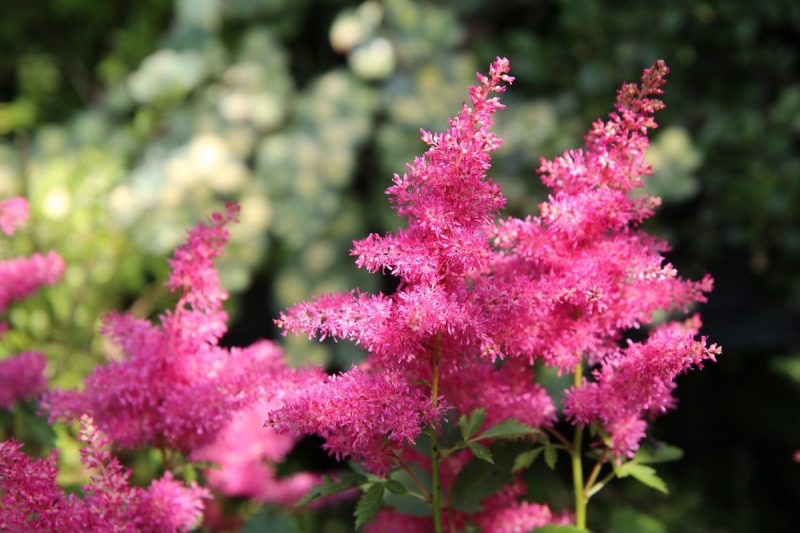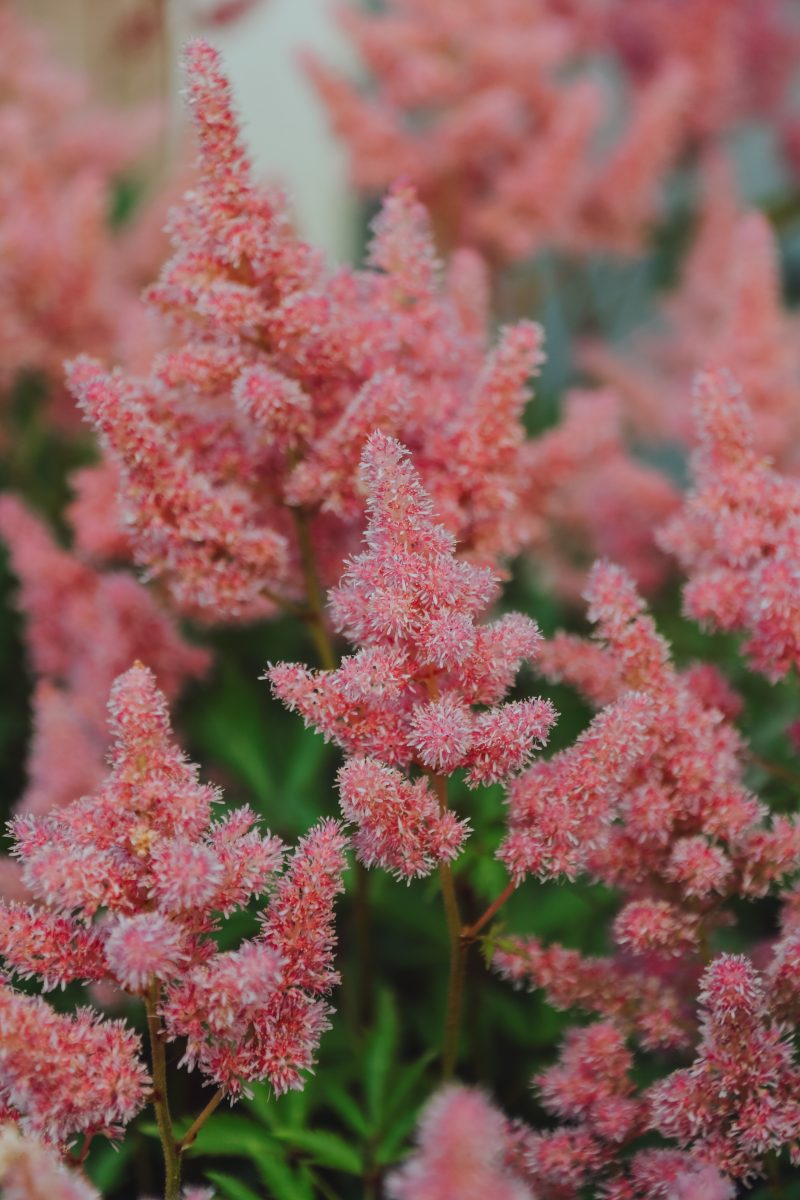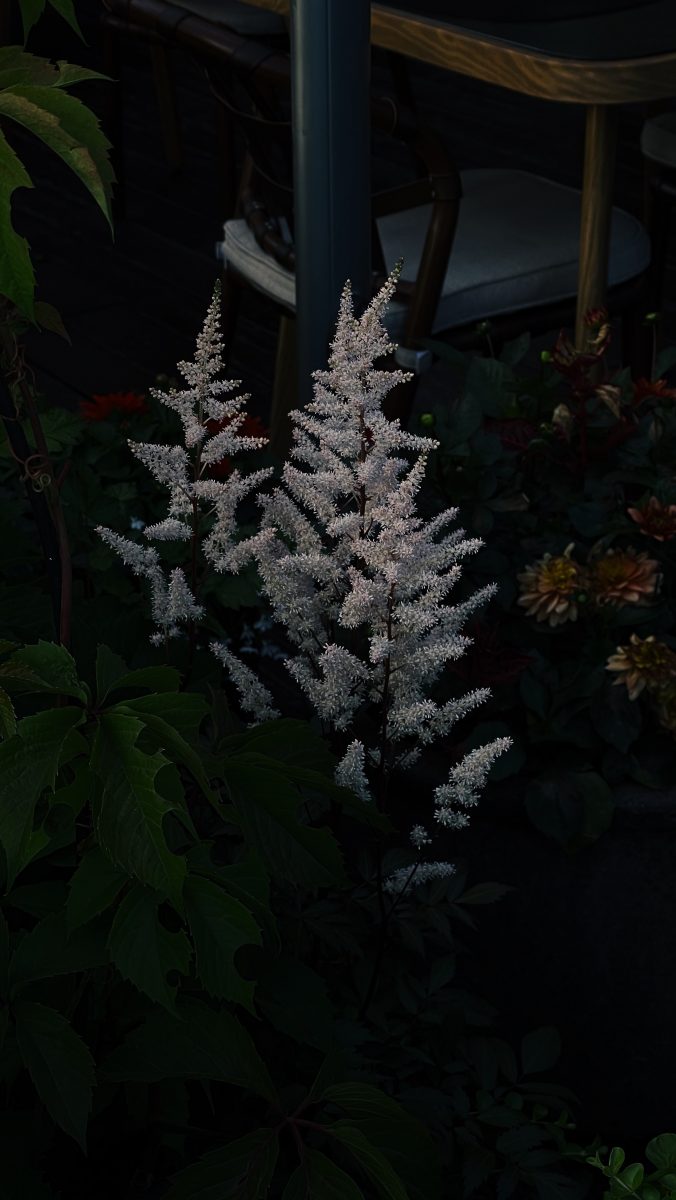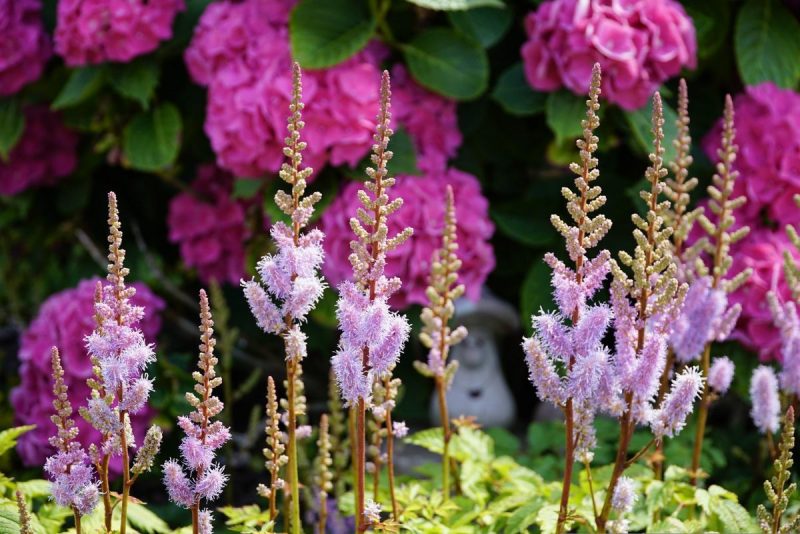Astilbe, planting guide and care work

Astilbe (Astilbe spp.) are perennial herbaceous plants, which are part of the Saxifragaceae family, originating from Asia. They are often found in gardens and parks, being cherished for their panicle-type inflorescences, variously colored (they can have shades of red, pink, purple, white), supported by tall and rigid stems. Depending on the cultivar, Astilbe will bloom from late spring to late summer. The leaves are green, alternatively-arranged, similar to ferns, which give the plant a bushy appearance.
Astilbe – varieties and cultivars
There are several species of Astilbe and numerous hybrid cultivars. The most common species are A. japonica, A. chinensis, A. thunbergii and A. simplicifolia, together with a large number of hybrids, found under the name of A x. arendsii.
- Astilbe x arendsii ‘Bridal Veil’: it blooms at the beginning or in the middle of the vegetative growth period. It has cream-white flowers;
- Astilbe x arendsii ‘Fanal’: with intense red flowers and lacy leaves, which change their color depending on the season;
- Astilbe x arendsii ‘Rheinland’: it is suitable for shaded places. The plant has pink flowers and dark green leaves;
- Astilbe chinensis ‘Visions in Red’: it has a compact appearance, intense red flowers and foliage with shades of bronze;
- Astilbe x japonica ‘Peach Blossom’: it has pale pink flowers and glossy green foliage. It can be grown in full sunlight or partial shade.



Environmental conditions
Light. The plants grow well both in bright and partially shaded places. Light directly influences the process of flowering and growth, but direct sunlight, in summer afternoons, can cause leaf burns.
Temperature. Astilbe is a cold-resistant species, even in areas with a harsher climate. However, in conditions of very low temperatures, the plants can be covered with dry leaves or sawdust, to protect the root.
Soil. It prefers fertile soils, moist, with a slightly acidic pH (6).
Astilbe – Care
Watering. It is done moderately, so that the soil is kept damp, but not too wet. In hot and dry periods, the plants are watered more often, using a sufficient amount of water. Periods of prolonged drought cause the drying of the leaves and flowers.
Fertilizing. To meet the nutritional requirements of the plants and to encourage flowering, it is recommended to apply fertilizers specially formulated for flowering plants.
Recommended products
-
You can find products on a different store
Change Store -
You can find products on a different store
Change Store -
You can find products on a different store
Change Store -
You can find products on a different store
Change Store -
You can find products on a different store
Change Store -
You can find products on a different store
Change Store -
You can find products on a different store
Change Store -
You can find products on a different store
Change Store -
You can find products on a different store
Change Store -
You can find products on a different store
Change Store -
You can find products on a different store
Change Store -
You can find products on a different store
Change Store -
You can find products on a different store
Change Store -
You can find products on a different store
Change Store -
You can find products on a different store
Change Store -
You can find products on a different store
Change Store -
You can find products on a different store
Change Store -
You can find products on a different store
Change Store -
You can find products on a different store
Change Store -
You can find products on a different store
Change Store -
You can find products on a different store
Change Store -
You can find products on a different store
Change Store -
You can find products on a different store
Change Store -
You can find products on a different store
Change Store
The plants can also be used as cut flowers, and in order to extend the flowering period and to preserve their freshness for a longer period, it is recommended to use a fertilizer specially formulated for cut flowers.
Recommended products
-
You can find products on a different store
Change Store -
You can find products on a different store
Change Store -
You can find products on a different store
Change Store -
You can find products on a different store
Change Store -
You can find products on a different store
Change Store -
You can find products on a different store
Change Store -
You can find products on a different store
Change Store -
You can find products on a different store
Change Store -
You can find products on a different store
Change Store -
You can find products on a different store
Change Store -
You can find products on a different store
Change Store -
You can find products on a different store
Change Store -
You can find products on a different store
Change Store -
You can find products on a different store
Change Store -
You can find products on a different store
Change Store -
You can find products on a different store
Change Store -
You can find products on a different store
Change Store -
You can find products on a different store
Change Store -
You can find products on a different store
Change Store -
You can find products on a different store
Change Store -
You can find products on a different store
Change Store -
You can find products on a different store
Change Store -
You can find products on a different store
Change Store -
You can find products on a different store
Change Store
Propagation. Astilbe can be propagated by dividing the bush or by seeds (less often). Dividing the bush can be carried out once every 3 years, in spring, having the role (with the exception of propagation) to improve the appearance of the plants, avoiding the thickening of the bush.
Pruning. It does not require regular pruning. Dried flowers on the plant can be nice looking even in winter. However, dried flowers can be removed after the flowering period or in early spring.
Recommended products
-
You can find products on a different store
Change Store -
You can find products on a different store
Change Store -
You can find products on a different store
Change Store -
You can find products on a different store
Change Store -
You can find products on a different store
Change Store -
You can find products on a different store
Change Store -
You can find products on a different store
Change Store -
You can find products on a different store
Change Store -
You can find products on a different store
Change Store -
You can find products on a different store
Change Store -
You can find products on a different store
Change Store -
You can find products on a different store
Change Store -
You can find products on a different store
Change Store -
You can find products on a different store
Change Store -
You can find products on a different store
Change Store -
You can find products on a different store
Change Store -
You can find products on a different store
Change Store -
You can find products on a different store
Change Store -
You can find products on a different store
Change Store -
You can find products on a different store
Change Store -
You can find products on a different store
Change Store -
You can find products on a different store
Change Store -
You can find products on a different store
Change Store -
You can find products on a different store
Change Store
Diseases and pests
The plants can be affected by powdery mildew, Fusarium wilt and leaf spots. Among the pests, mites and ladybugs can infest Astilbe.
Additionally
- The plants are not toxic to animals;
- It is recommended that the watering be carried out at the base of the plants, so that the foliage remains dry.















































































































































































































































































































































































































































